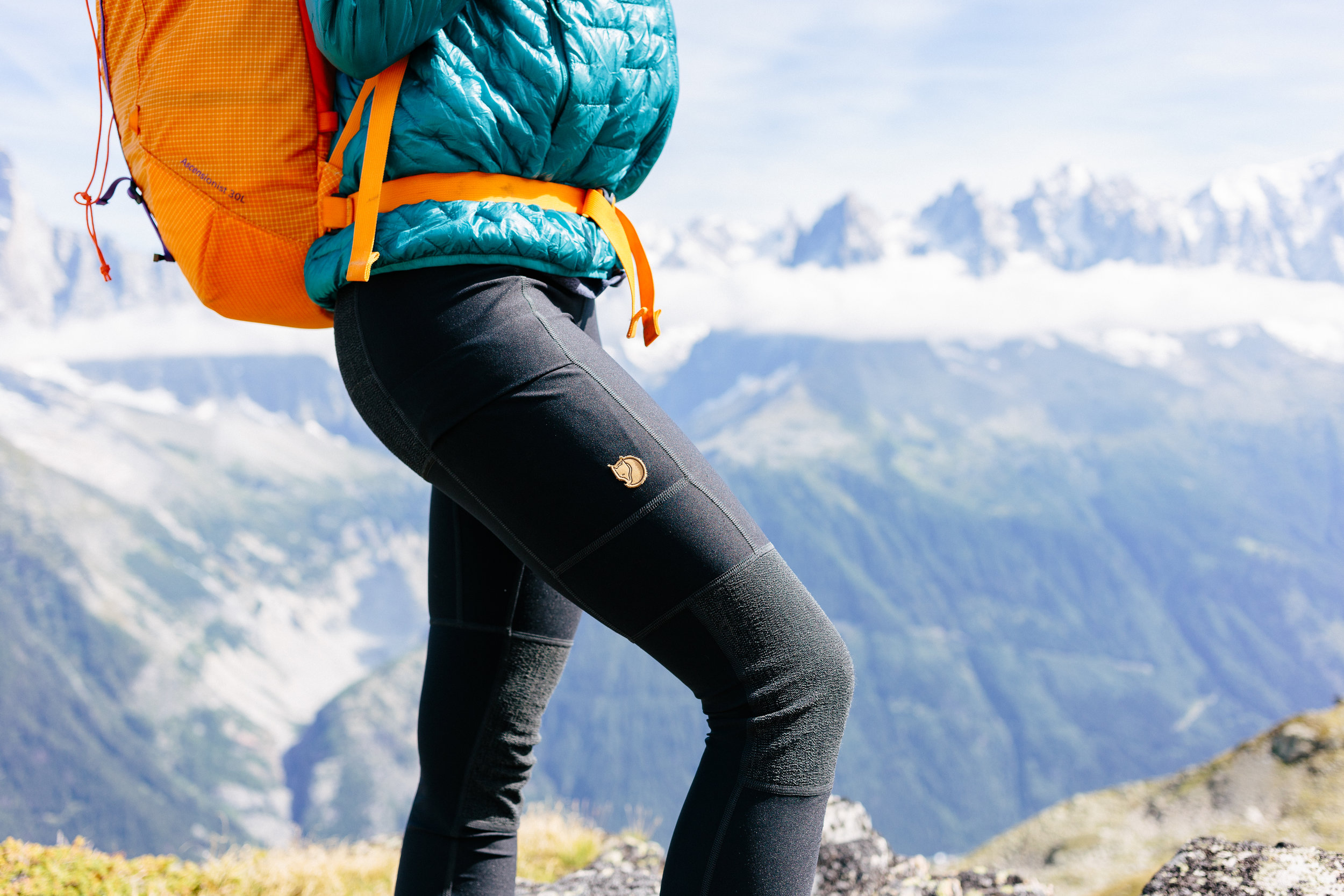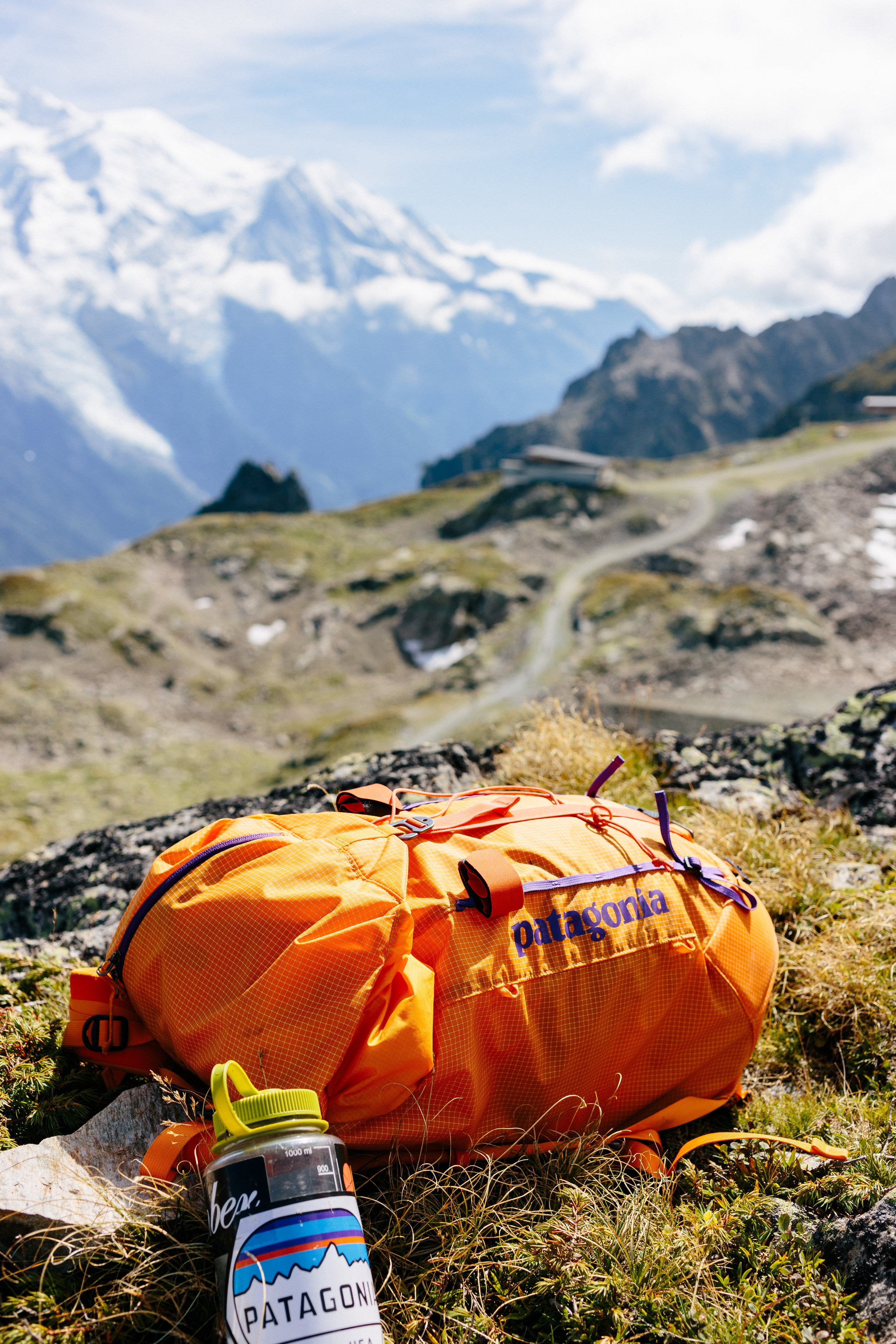My Alpine Essentials
Packing for the Alps was careful and considered. It was my first time going on a climbing and mountaineering holiday, so I had no past experience to go by; just an incessant amount of questions asked to my boyfriend and friends. I actually started making a packing list around a month before we went, mostly because I was so excited and also because I knew there would be certain specific things I would need to buy. In the end, I filled a 90L duffel bag and a 30L carry-on bag with outdoor gear for two weeks in the mountains. Here are some of my favourite pieces that I packed…
Patagonia’s Micro Puff
Fjallraven Abisko Tights
I am honestly completely in love with these tights. I’d been looking for some trekking tights for a while, as I often prefer to wear leggings than walking trousers (especially in warmer weather) and the Abisko Tights from Fjallraven ticked all the boxes. The fit of the tights is super comfortable; they just slip on without any zips or buttons on the waist or ankles, and are semi-high waisted which is great for wearing with a hiking bag. They are also incredibly practical, with two pockets on the side of each leg which means any essentials can be easily accessed. I tended to have my phone in one pocket, and something like my lip-balm or some cash in the smaller zip pocket on the other side. You could also easily carry a small map and compass in either of the pockets.
One of the best things about the tights is that I can also wear them for scrambling and climbing, due to the reinforced knees and bum-pad to stop the material from scuffing or tearing on rock. The leggings have the perfect amount of stretch for climbing, and a thick material that means I could wear them all year round, paired with some thermal leggings underneath in the winter. There’s honestly nothing I would change about these leggings - I love them!
Patagonia Ascensionist Pack
As I’m still new to climbing, I can’t say that I’ve tried out loads of different climbing bags before finding this one. This is actually my first climbing bag, but one that I’m pretty sure I’ll be using for a really long time. The Patagonia Ascensionist Pack is designed for Alpine climbing, with two different sizes (30L and 40L) and two different back lengths (S/M or L/XL) you can choose whichever combination is right for you. The material is super tough, and there are useful straps designed for ice axes on the outside of the bag. One of my favourite things about this bag is its simplicity - there aren’t excessive pockets or straps, just simply one main vessel and a pocket for some essentials in the lid. I also love the way the bag opens really wide so you can get to everything you need easily. Me and Harvey both have these bags and find them to be perfect for days out climbing, or overnight bivis in the mountains.
Scarpa Charmoz Mountain Boots
Back before I started learning about mountaineering, I didn’t even realise that you needed different boots for Alpine missions. Why can’t I just use my hiking boots? I quickly discovered that there are numerous reasons why mountaineering boots exist. Firstly, they are designed to be worn with crampons, so they are hardened at the edges and have a front and back ledge which crampons clip onto. Secondly, you might have to climb in these boots, so they have to have a strong and hard edge for standing on tiny rock ledges. And thirdly, they must be able to withstand Alpine conditions which means they are usually waterproof and much more durable than your normal hiking boot - they also fit higher up your ankle to protect your feet from rough terrain and possible thicker snow. There are probably much more differences between mountain and hiking boots, but these are just the observances I made.
Anyway, after a fair amount of research and advice, I chose the Scarpa Charmoz mountain boots for their durability, light weight, and comfort, and was more than happy with my choice when testing the boots out in Alpine conditions. It took a few long walks for the boots to mold to my feet and become less stiff, but once they did I felt really comfortable climbing in them and walking on difficult terrain. I’ll also be able to use these boots for winter mountaineering, and although they’re not cheap (at £280) they should last me a fair few years of mountain missions. It’s worth noting that you should buy mountaineering boots that fit a little bigger on your feet so you can fit two pairs of thick socks for winter without your toes being smashed by the hard edges. It’s definitely worth trying the boots on before buying!
Patagonia Micro Puff
Patagonia’s slogan for their latest Micro Puff campaign is ‘take nothing with you’, and they’re not far wrong. The Micro Puff is the ideal alpine jacket as it provides the same amount of warmth as down, yet due to being a synthetic material, it weighs practically nothing. Or rather a whole 200g to be more accurate. For me, putting the Micro Puff on when I’m cold offers instant warmth. I used it virtually every day when we were in the Alps, either in the evenings when it got chilly, or on an early morning glacier crossing before the sun came up. The jacket fits easily into it’s own pocket and can be slung in your bag, without hardly noticing it’s there. I love my Micro Puff and would highly recommend it if you’re looking for a lightweight insulation piece for active adventures.
Rab Alpine Bivi
Harvey and I both agreed that our favourite moments of our Alps trip were the overnight bivis we did. Neither of us had ever bivi’d before, and the experience of sleeping outside in mountainous environments completely hooked us. Packing a 30L rucksack for a night in the mountains isn’t easy, so I was ever-grateful for the light weight and small packsize of Rab’s Alpine Bivi Bag, at only 470g. Simple and minimalist, the bivis provided everything we needed for a night in the mountains - waterproof and breathable, with a super durable storm-proof fabric that we thankfully didn’t see the full potential of. The large zip means you have plenty of room for movement before settling in for the night, though I opted to leave mine slightly open so I could watch the stars from the comfort of my bed. I would highly recommend a Rab Alpine Bivi for anyone heading on a trip to the mountains. A night bivying under the stars is one you definitely won’t forget.
It’s worth noting that you don’t always need the top and most expensive pieces of gear to get out into the hills, but having the right kit is essential for comfort and efficiency in the mountains. A light bivi bag makes carrying a rucksack on a climb easier; a warm but light jacket is invaluable; and a good quality pair of mountain boots is definitely worth the extra money. In short, mountain sports can be expensive! But slowly investing in good quality gear will make your experience easier and more enjoyable in the long run.
There are definitely other essential pieces of gear I took to the Alps (crampons, harness, thermals and ice axe being a few!) but I’m going to save these items for a winter gear list later this year.
Let me know if you have any questions about specific pieces of gear in this list!
Athena ↟








